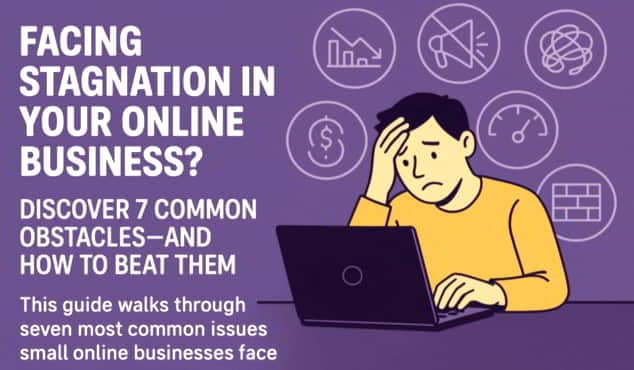Top 7 Small Business Challenges – And How to Solve Them

Estimated reading time: 6 Min
Struggling with growth, marketing, cash flow or tech? Discover the top 7 small-business obstacles—and how you can overcome them now.
Running a small business online can feel exciting—until you hit the wall. Whether it’s poor cash flow, uncertain marketing, tech overwhelm, or simply not growing fast enough, most entrepreneurs face these roadblocks at some point.
But these challenges aren’t the end of the road—they’re part of the learning curve. And with the right strategies in place, you can overcome them and make consistent progress.
This guide walks through the seven most common issues small online businesses face, and offers practical advice to help you move forward with confidence.
1. Build a Mindset That Keeps You Going
“There’s no failure, only feedback.” — Robert Allen
The biggest challenge often isn’t external—it’s mental.
Fear of failure. Doubt. Imposter syndrome. These internal battles can be more damaging than any competitor.
Success starts by seeing failure as feedback. Every setback shows you what to fix or try next.
Adopt a mindset focused on growth and learning. Skills develop through consistent effort—not overnight wins.
In addition to consistency, develop the habit of persistence.
Get used to being consistent and persistent, until you either succeed, or decide there’s a better way.
Progress will sometimes feel slow at times. But even the smallest task done daily—whether it’s improving your product or reaching out to a new customer—keeps you moving in the right direction.
2. Do the Research Others Skip
Many rush into business with an idea that sounds exciting—without checking if people actually want whatever it is.
Start by identifying a problem that people have that you can solve.
Study your potential market carefully.
What are people looking for that isn’t already being done well?
Once you’ve found a strong opportunity, commit to a niche that aligns with both your skills and interests. A niche that you are passionate about.
This alignment will make the workload more sustainable and your message more authentic.
Understand your ideal customer in detail.
What are they struggling with?
Where do they hang out online?
What kind of content grabs their attention?
This research will shape every decision you make—from what you sell, to how you promote it.
3. Differentiate or Disappear
The online space is crowded.
If your business doesn’t stand out, it’s likely to be ignored.
That’s why you need a clear Unique Value Proposition (UVP)—a simple way of explaining what makes your offer different and better.
Think about what you do better than others.
It could be outstanding support, a more personalised service, or simply faster delivery.
Also, learn from your competitors – study their content, offers, and customer feedback.
Use this information to sharpen your own approach—not to copy, but to find gaps you can fill.
Finally, stay agile.
Markets shift quickly—adapt, improve, and keep innovating to stay ahead.
4. Use Marketing to Create a Connection
If your business isn’t visible, it can’t grow.
Marketing isn’t just about pushing your product—it’s about building relationships.
Start by developing a consistent brand identity.
From your logo to your messaging, everything should reflect your values and speak to your audience.
Content marketing helps educate and build trust. Share blog posts, guides, or videos that help your audience solve problems or make informed choices.
Search engine optimisation (SEO) ensures that when people search for solutions, they can find you.
Social media lets you have real conversations. Reply to comments, ask questions, and build a loyal community around your brand.
Done well, your marketing becomes more than a sales tool—it becomes the engine of your business growth.
5. Prioritise Excellent Customer Service
Great service doesn’t just bring repeat custom—it turns customers them into advocates.
Even though most online interactions aren’t face-to-face, they still have the power to build strong relationships.
Make it easy for customers to reach you through multiple channels: email, live chat, or even social platforms.
Respond quickly and politely. Handle complaints with care. Ask for feedback regularly, and actually use it to improve your product or service.
Every happy customer has the potential to recommend you—and nothing beats word-of-mouth marketing.
6. Master Your Money
Financial uncertainty is one of the top reasons small businesses fail.
But with the right systems, you can avoid the chaos.
Start lean. Keep costs low in the beginning, and invest only where there’s a clear return.
Choose a revenue model that suits your goals—whether it’s selling products, offering services, or earning through affiliate links.
Track your income and expenses weekly. Use simple accounting tools to stay in control. And always have a backup plan for unexpected costs.
Cash flow—what’s coming in vs. what’s going out—matters more than profit on paper. Without steady cash flow, even a profitable business can go under.
7. Get Your Tech and Legal House in Order
Behind every smooth-running online business is a solid setup.
Choose the right tools to manage your website, customer relationships, and marketing.
They don’t have to be expensive—just reliable, scalable, and suited to your workflow.
Use automation where possible. Tools for assisting writing, managing links, email marketing messages, invoicing, and order handling can save many hours each week.
On the legal side, set things up properly from the start. Register your business if necessary, understand your tax obligations, and protect your brand assets.
Make sure your site is secure and your customer data protected. Privacy laws like GDPR are non-negotiable—and staying compliant builds trust.
FAQs: Common Small Business Challenges
Where should I start if launching an online business feels overwhelming?
Begin with market research. Focus on where your interests overlap with real customer demand.
How do I know if my niche is profitable?
Look at keyword trends, competitor success, and active online communities. These all point to demand.
Can a small business compete with big brands online?
Yes. Focus on offering a personal touch, quicker support, or a unique product that stands out.
What are effective low-cost marketing methods?
Use content marketing, SEO, and organic social media engagement. All require time, not necessarily money.
How can I improve customer service without a full team?
Set up a clear communication system. Respond quickly and use automation for FAQs and order updates.
Summary
Running a small online business brings real challenges—but none of them are unbeatable.
Start by developing the right mindset. Stay curious. Stay persistent. Then back it up with detailed research, a clear offer, and a marketing strategy that actually connects.
Keep your finances in check. Build relationships with customers through strong service. And use the right tech tools to stay efficient and secure.
Every problem you face is an opportunity to improve. The key is not to wait for perfection, but to keep showing up, keep learning, and keep going.
What’s your next move?
If you’ve got questions, feedback, or ideas of your own—get in touch or leave a comment. We’d love to hear from you.
😉
Richard
Suggested Resources
- The Lean Startup by Eric Ries – for building a business with limited resources
- Company of One by Paul Jarvis – ideal if you’re staying small on purpose
- Neil Patel’s Blog – for digital marketing advice
- GOV.UK – for small business legal and tax guidance


![Are Wealthy Affiliate Hubs Revolutionising Website & Content Development In [year]? A futuristic and sleek digital workspace designed for website management and content creation - Wealthy Affiliate Hubs](https://ml0yvzumdtic.i.optimole.com/cb:k6B_.1fa14/w:740/h:370/q:mauto/https://solobusinessmind.com/wp-content/uploads/2024/12/A-futuristic-and-sleek-digital-workspace-designed-for-website-management-and-content-creation-Wealthy-Affiliate-Hubs740x370-O.jpg)



